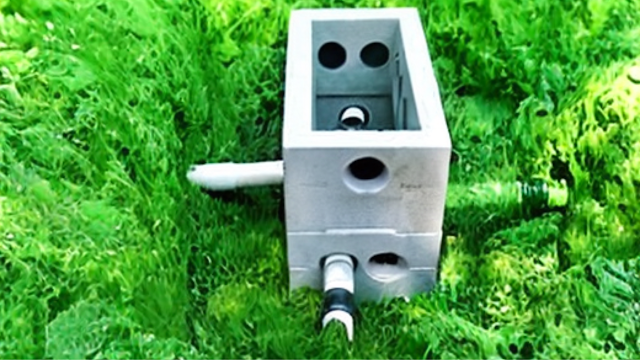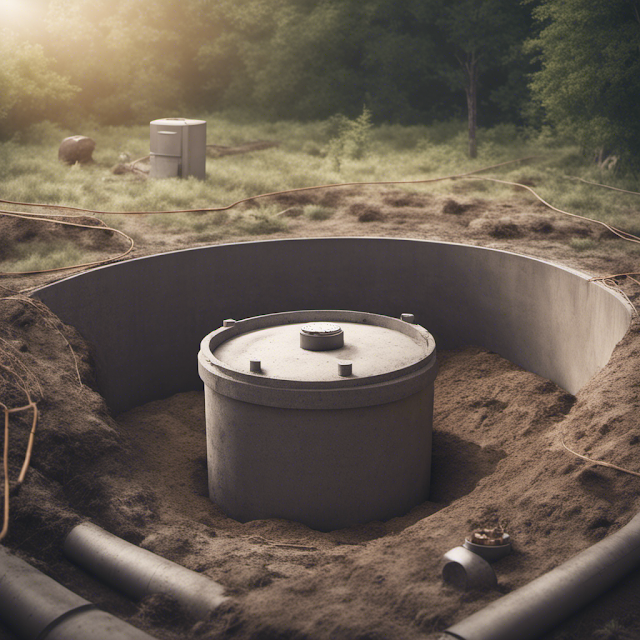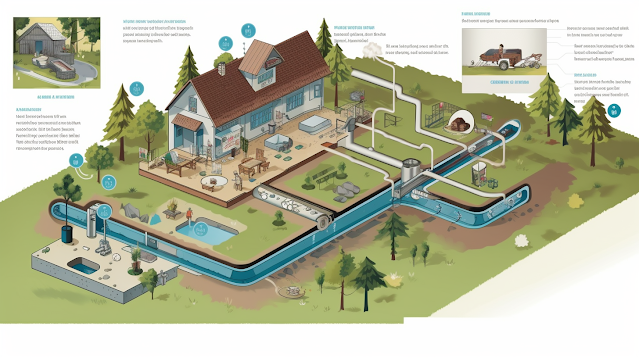Aerobic Septic Systems: How Do They Provide Enhanced Treatment?
 |
| Aerobic Septic Systems |
Curious about how aerobic septic systems provide enhanced treatment
for your wastewater? Look no further! In this article, we'll dive into the
fascinating world of aerobic septic systems and how they revolutionize waste
breakdown.
By introducing oxygen into the system, these innovative systems
promote the growth of bacteria that thrive on organic waste, breaking it down
more thoroughly and rapidly.
The result? Significantly cleaner effluent, reducing the
environmental impact and improving the quality of your wastewater treatment.
Get ready to discover the inner workings and benefits of aerobic
septic systems.
Key Takeaways
•
Oxygen-loving bacteria in
aerobic septic systems facilitate efficient waste breakdown.
•
Aerobic septic systems provide
cleaner and higher-quality effluent due to increased microbial activity.
•
Odor reduction is achieved in
aerobic septic systems through the efficient breakdown of waste by
oxygen-loving bacteria.
•
Compared to anaerobic systems,
aerobic septic systems offer superior treatment efficiency and produce less
foul-smelling gases.
The Role of
Oxygen-Loving Bacteria
Oxygen-loving
bacteria play a crucial role in aerobic septic systems by facilitating more
efficient waste breakdown and producing cleaner effluent. These bacteria, also
known as aerobic bacteria, thrive in environments rich in oxygen.
In aerobic
septic systems, oxygen is introduced into the system through various means,
such as air diffusers or mechanical aerators. This oxygenation promotes the
growth and activity of the oxygen-loving bacteria.
These
bacteria utilize the oxygen to break down organic matter present in the septic
tank, including solids and waste materials. As a result, the aerobic septicsystem provides enhanced treatment compared to traditional anaerobic septic
systems.
The
aerobic breakdown of waste by the oxygen-loving bacteria leads to a reduction
in the production of foul-smelling gases and the generation of cleaner effluent
that can be safely discharged into the environment.
Breaking Down Waste
More Efficiently
In
order to break down waste more efficiently, aerobic septic systems utilize
oxygen-loving bacteria. These bacteria play a crucial role in enhancing the
breakdown of waste materials, resulting in a more effective treatment process.
Oxygen-Loving Bacteria
Benefits
You'll be
amazed at the benefits that bacteria, which thrive in the presence of oxygen,
can bring to aerobic septic systems. These oxygen-loving bacteria play a
crucial role in the efficient treatment of wastewater.
Here are
three key benefits they provide:
•
Enhanced Waste Breakdown: The
bacteria in aerobic septic systems break down organic matter more efficiently
compared to anaerobic systems. They utilize oxygen to metabolize the waste,
resulting in faster decomposition and reduced sludge buildup.
•
Cleaner Effluent: Due to the
increased microbial activity in aerobic septic systems, the effluent produced
is cleaner and of higher quality. The bacteria effectively digest and convert
contaminants into harmless byproducts, resulting in a more environmentally
friendly discharge.
•
Odor Reduction: The presence of
oxygen-loving bacteria helps to minimize unpleasant odors in aerobic septic
systems. By breaking down waste more efficiently, they reduce the production of
foul-smelling gases, resulting in a more pleasant and odor-free environment.
Enhanced Waste Breakdown
You can see a
significant improvement in the breakdown of waste when oxygen-loving bacteria
are present. Aerobic septic systems utilize these bacteria to enhance the
treatment process.
These systems
introduce oxygen into the septic tank, creating an aerobic environment that
promotes the growth and activity of these bacteria. When waste enters the tank,
the oxygen-loving bacteria immediately begin breaking it down. They consume the
organic matter and convert it into simpler compounds, such as carbon dioxide
and water.
This enhanced
breakdown process results in a more efficient treatment of waste compared to
anaerobic systems. Furthermore, the byproducts of aerobic digestion are less
odorous and contain fewer harmful pathogens, making the effluent cleaner and
safer for the environment.
The presence of
oxygen-loving bacteria is crucial in achieving this enhanced waste breakdown in
aerobic septic systems.
Cleaner Effluent Production
When
oxygen-loving bacteria are present in aerobic septic systems, the effluent
produced is cleaner and safer for the environment. These bacteria, known as
aerobic bacteria, thrive in the presence of oxygen and play a crucial role in
breaking down organic matter in septic tanks. As they consume the waste, they
produce byproducts that are less harmful to the environment.
Here are
three ways in which aerobic septic systems provide cleaner effluent:
•
Enhanced oxygen supply: Aerobic
septic systems are designed to provide a continuous supply of oxygen to support
the growth of aerobic bacteria. This ensures optimal conditions for the
bacteria to thrive and efficiently break down waste.
•
Increased waste breakdown: The
presence of oxygen-loving bacteria in aerobic septic systems leads to enhanced
waste breakdown. These bacteria break down complex organic compounds, reducing
the concentration of pollutants in the effluent.
•
Improved treatment efficiency:
Compared to traditional anaerobic septic systems, aerobic systems offer
superior treatment efficiency. The aerobic bacteria in these systems break down
waste at a faster rate, resulting in a higher level of treatment and cleaner
effluent.
Overall, the
presence of oxygen-loving bacteria in aerobic septic systems significantly
improves the quality of the effluent, benefiting both the environment and
public health.
Enhancing Treatment of
Effluent
Enhancing
treatment of effluent is crucial in maintaining the cleanliness and quality of
wastewater discharge. By utilizing aerobic septic systems, you can harness the
power of oxygen-loving bacteria to break down waste more efficiently, resulting
in enhanced treatment of effluent.
This
process not only improves the overall performance of the system but also
provides numerous benefits. These benefits include reduced odor, lower levels
of harmful contaminants, and ultimately, cleaner effluent.
Oxygen-Loving Bacteria's
Role
The oxygen-loving bacteria in
aerobic septic systems play a crucial role in breaking down waste and producing
cleaner effluent. These bacteria are essential for the efficient treatment of
wastewater, as they thrive in oxygen-rich environments and work to decompose
organic matter.
Here are three key factors that
highlight the importance of these bacteria in aerobic septic systems:
•
Oxygen supply: The presence of
oxygen in aerobic septic systems creates an ideal environment for thesebacteria to thrive. This allows them to break down waste more effectively and
efficiently compared to anaerobic systems.
•
Enhanced treatment: The aerobic
bacteria in these systems are highly efficient in breaking down complex organic
compounds, such as fats, oils, and proteins. This results in a more thorough
treatment process and ultimately cleaner effluent.
•
Nutrient removal: Along with
waste breakdown, these bacteria also play a vital role in removing excess
nutrients like nitrogen and phosphorus from the wastewater. This helps prevent
pollution and protects the surrounding environment.
Benefits of Enhanced
Treatment
You'll experience the benefits
of improved wastewater treatment with aerobic septic systems. These systems
provide enhanced treatment by utilizing oxygen-loving bacteria to break down
waste more efficiently, resulting in cleaner effluent.
One of the main benefits is
the reduction of harmful substances in the effluent that can harm the
environment and human health. The aerobic process promotes the breakdown of
organic matter, including pathogens, into harmless byproducts. This leads to a
significant reduction in the presence of disease-causing organisms in the
effluent, making it safer for disposal or reuse.
Additionally, aerobic septic
systems have a higher capacity for nitrogen removal compared to traditional
anaerobic systems, thus reducing the risk of groundwater contamination.
With improved treatment
capabilities, aerobic septic systems offer a more environmentally friendly and
sustainable solution for wastewater management.
Cleaner Effluent Advantages
By utilizing oxygen-loving
bacteria, aerobic septic systems break down waste more efficiently, resulting
in cleaner effluent and a safer disposal or reuse option for you. These systems
offer several advantages over traditional septic systems, including:
•
Enhanced treatment: Aerobic
septic systems provide a higher level of treatment compared to anaerobic
systems. The presence of oxygen allows aerobic bacteria to thrive and
effectively break down organic matter, resulting in a more thorough removal of
harmful pathogens and pollutants.
•
Reduced odors: The aerobic
process in these systems significantly reduces foul odors commonly associatedwith septic systems. The bacteria consume the organic waste and convert it into
carbon dioxide and water, minimizing unpleasant smells.
•
Lower maintenance: Due to the
efficient breakdown of waste, aerobic septic systems require less frequent
pumping and maintenance. This can save you time and money in the long run.
Increased Oxygen
Levels: A Key Factor
To
achieve enhanced treatment, aerobic septic systems rely on increased oxygen
levels, which promote the growth of beneficial bacteria. In these systems,
oxygen is introduced either through mechanical means or natural processes like
aeration.
The
presence of oxygen creates an ideal environment for aerobic bacteria, which are
responsible for breaking down organic matter more efficiently. These bacteria
utilize oxygen to metabolize the waste, converting it into carbon dioxide,
water, and biomass.
The
increased oxygen levels also discourage the growth of anaerobic bacteria, which
produce foul-smelling gases and are less efficient at breaking down waste.
Comparing Aerobic
and Anaerobic Systems
Now
let's delve into the comparison between aerobic and anaerobic systems.
Understanding the differences between these two types of systems is crucial in
determining the most suitable wastewater treatment method for your needs.
1.
Oxygen Requirement:
•
Aerobic systems rely on oxygen
to break down organic matter efficiently, promoting the growth of oxygen-loving
bacteria. This enables them to decompose waste more rapidly and produce cleaner
effluent.
•
In contrast, anaerobic systems
function in the absence of oxygen. They utilize anaerobic bacteria to decompose
organic matter, but the process is slower and less efficient compared to
aerobic systems.
1.
Treatment Efficiency:
•
Aerobic systems excel in
treating wastewater by providing enhanced treatment capabilities. They've
higher treatment efficiency, reducing the levels of harmful bacteria and
contaminants in the effluent to a greater extent.
•
Anaerobic systems, while still
effective to some extent, tend to produce effluent with higher levels of
contaminants and require additional treatment steps to achieve the desired
water quality.
1.
Maintenance and Operation:
•
Aerobic systems typically
require more frequent maintenance due to their reliance on mechanical
components, such as blowers and pumps. Regular monitoring and servicing are
necessary to ensure optimal performance.
•
Anaerobic systems, on the other
hand, generally have lower maintenance requirements as they don't rely on
mechanical components as heavily. However, periodic checks and maintenance are
still necessary to prevent any issues that may arise.
The Importance of
Proper Maintenance
Regular
maintenance is essential to ensure optimal performance and prevent any
potential issues with your aerobic septic system. Neglecting proper maintenance
can lead to costly repairs and system failures. To keep your aerobic septic
system functioning efficiently, there are a few key tasks that must be
performed regularly.
Firstly,
it's crucial to regularly inspect and clean the air diffusers. These diffusers
introduce oxygen into the system, which is necessary for the aerobic bacteria
to thrive. Over time, these diffusers can become clogged with debris, reducing
their effectiveness. Cleaning or replacing them as needed will maintain the
proper airflow and ensure the efficient breakdown of waste.
Additionally,
regular pumping of the septic tank is necessary. The frequency of pumping
depends on the size of the system and the number of users. Pumping removes
accumulated solids from the tank, preventing them from entering the aerobic
treatment unit and causing clogs or system failures.
Lastly,
monitoring the system's control panel and alarms is crucial. These indicators
provide valuable information about the system's performance and can alert you
to any potential issues. Regularly checking these components will allow you to
address problems promptly and prevent any major malfunctions.
Benefits of Aerobic
Septic Systems
With
an aerobic septic system, you'll experience cleaner effluent and more efficient
waste breakdown thanks to oxygen-loving bacteria. These bacteria thrive in the
presence of oxygen and are highly effective at breaking down organic matter in
the wastewater.
Here
are three benefits of aerobic septic systems:
•
Enhanced treatment: The
oxygen-loving bacteria in aerobic septic systems are more efficient at breaking
down waste compared to anaerobic bacteria. This results in a higher level of
treatment, reducing the presence of harmful pathogens and pollutants in the
effluent.
•
Odor control: Aerobic septic
systems minimize unpleasant odors by promoting aerobic digestion, which
eliminates the production of foul-smelling gases like hydrogen sulfide.
•
Eco-friendly: By utilizing
oxygen-loving bacteria, aerobic septic systems produce effluent that's cleaner
and safer for the environment. The treated wastewater can be safely discharged
into the ground or reused for irrigation, reducing the strain on water
resources.
Frequently Asked Questions
How Do Aerobic Septic
Systems Work?
Aerobic septic systems work by utilizing oxygen-loving bacteria to
efficiently break down waste and produce cleaner effluent. This enhanced
treatment process is achieved through the introduction of oxygen, promoting the
growth of beneficial bacteria.
What Are the
Main Differences Between Aerobic and Anaerobic Septic Systems?
Aerobic septic systems provide enhanced treatment by using
oxygen-loving bacteria to break down waste more efficiently. They differ from
anaerobic systems in that they require oxygen and produce cleaner effluent.
What Are the
Benefits of Using Aerobic Septic Systems?
Aerobic septic systems provide enhanced treatment by utilizing
oxygen-loving bacteria to break down waste more efficiently. This results in
cleaner effluent and reduces the risk of groundwater contamination.
What Factors
Contribute to the Enhanced Treatment Provided by Aerobic Septic Systems?
Factors that contribute to enhanced treatment in aerobic septic
systems include the presence of oxygen, which allows oxygen-loving bacteria to
thrive and break down waste more efficiently, resulting in cleaner effluent.
Why Is Proper
Maintenance Important for Aerobic Septic Systems?
Proper maintenance is crucial for aerobic septic systems because
neglect can lead to bacterial imbalance and system failure. Regular
inspections, pump-outs, and oxygen supply checks ensure optimal performance,
preventing costly repairs and environmental contamination.
Conclusion
In conclusion, aerobic septic
systems offer a revolutionary solution for wastewater treatment. By introducing
oxygen-loving bacteria, these systems break down waste more efficiently and
produce cleaner effluent. The increased oxygen levels play a key role in
enhancing treatment, ensuring a higher quality of wastewater treatment.
When compared to traditional
anaerobic systems, aerobic septic systems prove to be more efficient and
environmentally friendly. However, proper maintenance is crucial to reap the
full benefits of these systems.
Overall, aerobic septicsystems provide an advanced and sustainable approach to wastewater treatment.



.png)






Comments
Post a Comment